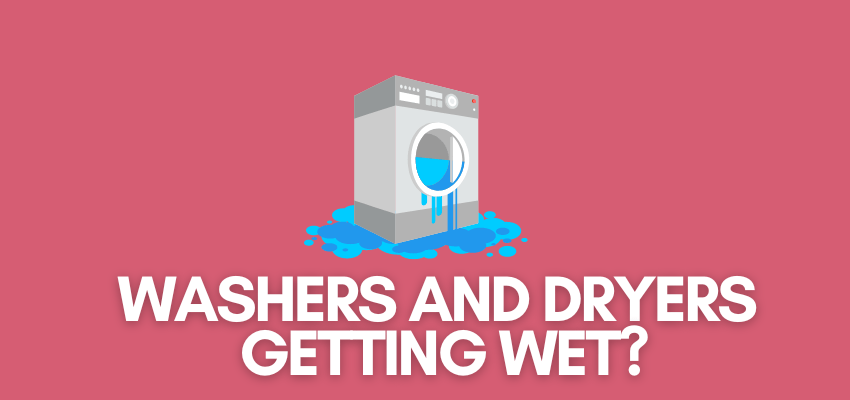Table of Contents
Last Updated on: 17th June 2023, 06:50 pm
Washers and dryers are two essential household electronics that make our lives easier. However, sometimes, the washers and dryers get wet, especially in the rainy season, and it messes with everything. Humidity and wetness are not ideal for the longevity of the appliance.
If the washing machine and dryer stop working for some reason, it gets difficult to do the laundry, whether it’s a washing machine and dryer combo or a separate washing machine and dryer.
Therefore, it’s vital to take good care of washing machines and dryers to keep them safe and sound.
Have you ever wondered what would happen if your washer or dryer gets wet due to rain? Most laundry areas are open and exposed to sunlight, rain, and air.
| Disclaimer: As an Amazon Associate, I earn from qualifying purchases. |
So it’s highly unlikely that the washing machine or such appliance doesn’t get wet in the rain.
Sometimes, it’s not the direct rain but the humidity in the air, especially after the rain.
It’s not an ideal situation if a washer or dryer gets wet, and that’s why some people prefer an indoor laundry area at home.
Anyway, let’s discuss a few aspects of the washer and dryer getting wet.
4 Reasons Why a Washer or Dryer Shouldn’t Get Wet
Let’s take a look:
1. Not waterproofed
Washers and dryers aren’t waterproof so try to do everything you can to keep your washers and dryers protected from rain and humidity.
Even though washing machines and dryers process/use water while washing or drying clothes, they’re still vulnerable.
Keep your washers and dryers safe from rain and thunderstorm, especially if you have an outdoor laundry area at home. Most people put their outdoor laundry area under the shade to keep their washing machine protected from rain and sunlight.
- Suitable for toilet, kitchen, bathroom, balcony lighting, patio, eaves, awning. Avoid staining, stripping, aging and rust on the washing machine.
- Quilted fabric tip washing machine cover, sun protection. Romantic and elegant design, can be used for interior decoration or as a gift.
- Pre-Window Design- Pre-cut window design allows you easy access to the control panel and lid. You can open your machine without removing the cover, which is very simple and convenient.
- Size - L23 x W23 x H33 inches (L60 x W60 x H85 cm). Our cover fits most top or front loading washing machines / dryers.
- Dustproof, waterproof, sunscreen, smokproof, encrypted silver coating, good thermal insulation, UV resistance.
2. Gaps and cracks
There are several gaps and cracks in the washing machine and dryer bodies as they’re made by assembling several parts. So there is a possibility that those gaps and cracks on the washer body would let the water drops get inside.
Use washing machine covers to protect your washing machines and dryers. The water could seep in and damage the machinery if not taken care of the whole situation.
This is probably one of the reasons why the washer and dryer shouldn’t get wet.
3. Electric wiring
All washing machines and dryers require electricity to work. Therefore, several electric wires, boards, and chips are installed in the washer or dryer’s body to make it functional.
If a washer or dryer gets wet due to any reason, the chances are, the electric wires could trip and burn some of the parts inside the washing machine.
It’s a no-brainer that the electric wiring of the washing machine or dryer shouldn’t be exposed to rain or humidity.
4. Exposed to sunlight
When a washer or dryer is exposed to sunlight, there is a chance that it could also be exposed to rain and fog during the winter. Try to keep your washing machines and dryers in the covered area or under the shade.
- A zipped cover for dust protection
- It is dustproof and stain resistant
- This cover significantly is easy to clean
- Zipper closure makes it convenient to use
- Thicken PEVA material is sturdy, durable, and waterproof
Moreover, when any device or product is exposed to the sun for a longer period, it gets faded over time. So nobody wants a dull and faded home appliance at home.
What Washing Machine Parts Shouldn’t Get Wet?
The following washing machine parts should not get wet because they can be damaged or even cause a safety hazard if they come into contact with water:
- Motor: The motor is an electrical component that powers the washing machine’s drum. Water can damage the motor’s internal components and cause it to malfunction, leading to the need for costly repairs or replacement.
- Control panel: The control panel is where the user interacts with the washing machine, selecting programs and adjusting settings. Water can damage the electrical components within the control panel, causing it to malfunction or fail. This could render the washing machine unusable and may require expensive repairs or replacement.
- Circuit board: The circuit board is responsible for controlling the washing machine’s various functions. Water can damage the circuit board’s sensitive electronic components, causing it to malfunction or fail completely. This could result in the washing machine not working properly or not working at all.
- Timer: The timer controls the duration of the washing cycle. Water can damage the timer’s delicate internal components, causing it to malfunction and result in incorrect or erratic timing of the washing cycle.
- Heating element: The heating element is responsible for heating the water in the washing machine. If the heating element comes into contact with water, it can cause a short circuit and potentially result in an electrical shock or a fire hazard.
Let me be clear; these components are not designed to withstand exposure to water, and if they do get wet, they can cause serious damage to the washing machine and even pose a safety hazard.
Therefore, it is important to take appropriate precautions to keep them dry during the use and maintenance of the washing machine.







